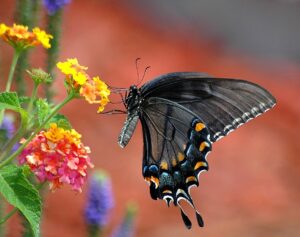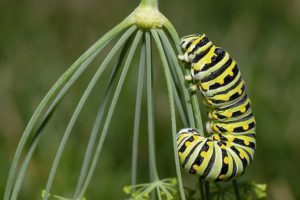Black Swallowtail Butterfly Caterpillar Guide

The eastern black swallowtail butterfly belongs to the family Papilionidae and includes more than 600 species worldwide, these butterflies can be found throughout Canada to northern Mexico, parts of western United States as well as most of the eastern United States, New Mexico, Nevada, California, throughout New Hampshire and Colorado. The eastern black swallowtail butterflies are common visitors to farmlands, open fields and can be frequently seen in urban gardens or landscapes.
Proper identification of the eastern black swallowtail butterfly includes black wings with light-colored spots, or scales, on the trailing edges, on the male the spots are pale green, and on the female, the spots are iridescent blue. The undersides of the wings have bright orange spots.
Affiliate Disclaimer
As the owner of this website and a ShareASale Affiliate, I’ve tracked down special deals for some of the products mentioned here. When you use the links on this page to make a purchase I may get a small commission and you will get a great bargain. It’s a WIN-WIN for both of us.
Black Swallowtail Butterfly life cycle

It’s quite common for the black swallowtail butterfly to visit gardens or urban landscapes. The courtship of the male and the female last for up to 45 seconds. The male and female will flutter near each other flying approximately at a distance of 20 meters away from where the courtship started. Mating will take place once the butterfly lands.
The female black swallowtail butterfly will lay from 200-430 pale yellow eggs at the rate of about 30-50 per day individually on the undersides of the host plant’s leaves. The eggs will hatch in 4-10 days depending on the temperature.
The caterpillars that emerge are a mixture of green with yellow bands or saddles around their middle remaining at this stage for 3-4 weeks. Within 10-20 days the caterpillar forms or turns into a chrysalis, the chrysalis is attached to or is held to the host plant by a thin silk thread. The chrysalis will turn clear right before the adult emerges. After another 6-14 days an adult black swallowtail butterfly emerges.
Food source of black swallowtail butterfly
- Milkweed
- Phlox
- Clover
- Thistles
- Caraway
- Zinnias
- Mexican sunflower
Food source of black swallowtail butterfly caterpillar
- Parsnip
- Celery
- Carrots
- Dill
- Queen Anne’s lace
Black Swallowtail butterfly Fun facts
- The black swallowtail butterfly has a wingspan of 3-4 inches
- The black swallowtail butterfly habitat includes woodlands, marshes, meadows, gardens, near roads, lakes, streams, farms, desert, lawns, near cities
- The black swallowtail caterpillar at maturity has an orange horn-like gland on its head called an osmeterium
- The black swallowtail butterfly is the official state butterfly of New Jersey
- The young Caterpillar is black
- The black swallowtail butterfly fly faster than other swallowtails
- An older caterpillar is green
- The black swallowtail butterfly goes through 5 stages called instars
- If the butterfly senses that danger is close it releases a foul odor from its gland
- The black swallowtail flies closer to the ground than other swallowtails
- Holding their abdomens above their wings keeps them warm
The final word on the black swallowtail butterfly caterpillar
The black swallowtail butterfly can bring much activity into your garden and landscapes as you watch them in their natural habitat. These butterflies are welcome in many home gardens especially wildlife gardens. By following this guide you will not only be creating the perfect home for these butterflies but for the caterpillars as well as you contribute to their lifecycle. So go ahead and create that natural habitat in your backyard as you help in giving nature a helping hand.
About the author
Norman loves being in the garden, both at home and for his job....
he is 'Natures Little helper' being outdoors, growing his vegetables and flowers from an early age.
Now having spent over 22 years in the profession he want to give some of his knowledge to others...
his vast array of hints and tips you will find scattered over this site will help you no end growing plants in your garden.

Thank you for introducing me to the Black Swallowtail Butterfly Caterpillar. I never knew about them until now, let alone how many species were in the Papilionidae family. I found it extra interesting that they eat celery and carrots, as I never really thought about what butterflys eat. When I was reading about thier life cycle I was left wondering what is their life expectancy from hatching from the egg to the end of their life as a butterfly?
They can live anywhere from 10 to12 days and then for some its 35 to 50 days. Hope this helps.
Hi Norman,
Thanks for this guide on the Black Swallowtail Butterfly Caterpillar, it was very interesting. I am not too familiar with the many butterflies and their names in my area, I live in Ontario Canada, but I will keep an eye out to see if I happen to spot the Black Swallowtail.
I enjoyed the fun facts that you have included as well. I do have Zinnia’s in my garden as well as Clover, so I might just come across one of these butterflies.
Jenny.
Hello I am so happy to help, the black swallowtail can live anywhere from 10 to 12 days and some can live as long as 35 to 50 days. Hopes this helps.
Hi Norman,
Will these destroy my garden? I found them on the Dill. Should I move the caterpillars to the field where there is clover?
Thanks,
Kim
someone gave me several they found in their garden.
can they live in my classroom?